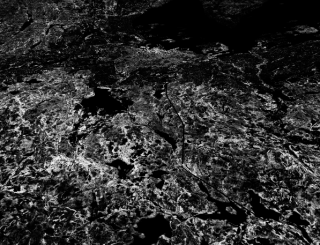Article
Landscapes between signal and data: Formal identification and analysis of forest clearings in Oslo through lidar data
- Schob, Maximilian|Callejas, Luis

This article investigates how airborne light detection and ranging (lidar) point cloud data and their embedded data models can serve as the basis for revealing, studying, and manipulating clearings in the urban forest situated in the north of Oslo. Furthermore, the article describes the unique highresolution public and open digital data and infrastructure that surveys these landscapes in Norway. The main research question is concerned with whether the extensive public data available in Norway can reveal unseen and undervalued clearings with potential value as remnants of an important and unique cultural landscape practice. The methodology involves sampling data models from prevalent publicly available urban planning and forest management datasets and applying them to high-resolution lidar scans of the forest. Beyond the initial identification of precise landscape figures, this methodology introduces a creative visual workflow to appreciate, evaluate and work with the previously undervalued clearings in the Oslo forest. The article further hypothesizes on how certain morphological conditions of the Oslo forest clearings are only thoroughly visible and open to analysis and manipulation through high-resolution lidar surveys. The value of the particular case of Oslo is twofold. First, the databases in Norway for performing such analysis are public, facilitating the necessary accessibility to conduct such research. Second, a history of careful urban forest management, reconciling the public use of the forest with the interests of commercial forestry, have developed into unique and delicate ways to perform clear-cutting in the urban forest around Oslo. The convergence of these two outlined unique conditions present the need to perform this study in Oslo rather than in other locations; however, the workflow and methodology described here could be applied to other forested areas in the presence of available data and unique aspects of clear-cutting that can be re-valued through imaging. The nature of lidar data collection, analysis, and applications in a design workflow are generally understood, and its disciplinary implications are generally well delineated (URECH et al. 2020); however, working creatively with the data opens an under-explored arena for design disciplines, one in which the aesthetic, poetic and formal evaluation of the data is used not to classify the land and tree cover (BELL et al. 2018), but to instead scout and reveal landscape entities typically seen as of lesser value or simply under-described. As geospatial data becomes raw matter and part of the everyday design workflow of architecture and landscape architecture practice (URECH et al. 2020), designers need new ways to frame data as creative media in these disciplines. In this article, we describe the base condition of geospatial data as multivariate (ASH et al. 2018) – many definitions and derivatives of itself in dependence on the systems they are embedded in. We introduce terminologies such as model sampling and data scouting to give way to the formulation of data models in landscape architecture, with a particular focus on lidar surveys of the forest around Oslo.

